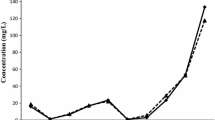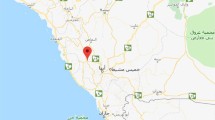Abstract
In this study, a total of 10 bottled water samples (10 brands) from natural springs and wells packed in 1.5 l plastic bottles were randomly purchased in Khuzestan Province market. The selected bottled water brands were analyzed for 40 parameters using ICP-OES, IC, HGAAS, spectrophotometric, titration and conductometric methods. Major and trace element concentrations differ among analyzed bottled waters, reflecting the different lithologies of the aquifers from which they are extracted. The studied bottled waters are classified as Ca–Mg–HCO3 type according to Piper diagram, and as “low mineral concentration” type based on Van der Aa’s classification. The studied mineral water brands are classified as “very oligohaline”, “oligohaline”, and “fresh” water types with “very low” to “low mineral concentration” according to Stuyfzand’s classification. The amount of nitrate in two and three samples, falling in the range of 20–34 mg/l, exceeds its permitted levels according to Iranian national standard for natural mineral water and USEPA standards, respectively. Since Iranian national standard defines a permissive level for ∑(nitrate + nitrite), this total amount (>20 mg/l) exceeds its allowed level in three samples. All analyzed samples, however, are in accordance with WHO regulations regarding all parameters for which action levels are defined. The fact that nitrate concentrations in some bottled water brands are above the standard levels has no geologic reason, but it is due to human activities, especially the use of nitrate-bearing chemical fertilizers.





Similar content being viewed by others
References
Baba A, Ereeş FS, Hıçsönmez Ü, Cam S, Özdılek HG (2008) An assessment of the quality of various bottled mineral water marketed in Turkey. Environ Monit Assess 139:277–285
Birke M, Rauch U, Harazim B, Lorenz H, Glatte W (2010) Major and trace elements in German bottled water, their regional distribution, and accordance with national and international standards. J Geochem Explor 107:245–271
Bories PN, Bories C (1995) Nitrate determination in biological fluids by an enzymatic one-step assay with nitrate reductase. Clin Chem 41:904–907
Cicchella D, Albanese S, De Vivo B, Dinelli E, Giaccio L, Lima A, Valera P (2010) Trace elements and ions in Italian bottled mineral waters: identification of anomalous values and human health related effects. J Geochem Explor 107:336–349
Dinelli E, Lima A, De Vivo B, Albanese S, Cicchella D, Valera P (2010) Hydrogeochemical analysis on Italian bottled mineral waters: effects of geology. J Geochem Explor 107:317–335
Duffus J (1980) Environmental toxicology (resource and environmental sciences series). Edward Arnold Publishers Ltd., London, England
Institute of standards and industrial research of Iran (2011) Natural mineral water—specifications and test methods—2441, 2nd. Revision
Khodabandeh AA, Amini Fazl A (1995) Geological map of Osku, 1:100000. Geological survey of Iran, Tehran
Krachler M, Shotyk W (2009) Trace and ultratrace metals in bottled waters: survey of sources worldwide and comparison with refillable metal bottles. Sci Total Environ 407:1089–1096
Lau OW, Luk SF (2002) A survey on the composition of mineral water and identification of natural mineral water. Int J Food Sci Technol 37:309–317
Llewellyn PG (1974) Geological map of Palganeh 1:100000. National Iranian oil company, Geological and exploration division, Tehran
Mesa JC, Armendáriz CR, de la Torre AH (2003) Nitrate intake from drinking water on Tenerife Island (Spain). Sci Total Environ 302:85–92
Misund A, Frengstad B, Siewers U, Reimann C (1999) Variation of 66 elements in European bottled mineral waters. Sci Total Environ 243:21–41
Mohajjel M (1992) Geological map of Golpayegan 1:100000. Geological Survey of Iran, Tehran
Naddeo V, Zarra T, Belgiorno V (2008) A comparative approach to the variation of natural elements in Italian bottled waters according to the national and international standard limits. J Food Compos Anal 21:505–514
National Iranian oil company (2003) Geological map of Dorudzan 1:100000. Geological and Exploration Division, Tehran
National Iranian oil company (undated) Geological map of Aleshtar 1:100000. Geological and Exploration Division, Tehran
Peh Z, Šorša A, Halamić J (2010) Composition and variation of major and trace elements in Croatian bottled waters. J Geochem Explor 107:227–237
Sedaghat M (2008) Earth and water resources: ground waters. PNU University Press, Tehran, p 288
Sedaghat ME, Dabaghian Nezhad A (1996) Geological map of Darenjan 1:100000. Geological Survey of Iran, Tehran
Sedaghat ME, Shaverdi T (1975) Geological map of Yasouj 1:100000. Geological Survey of Iran, Tehran
Shotyk W, Krachler M, Chen B (2006) Contamination of Canadian and European bottled waters with antimony from PET containers. J Environ Monit 8:288–292
Stuyfzand PJ (1986) A new hydrogeochemical classification of water types: principles and application to the coastal dunes aquifer system of the Netherlands. In: Proceedings 9th Sea water Intrusion meeting (SWIM), Delft (The Netherlands), 641–656
Stuyfzand PJ (1993) Hydrochemistry and hydrology of the coastal dune area of the Western Netherlands. Ph.D. thesis, Free University, Amsterdam, p 366
USEPA (2003) National Primary Drinking water standards. U.S. Environmental Protection Agency of the United States of America
Van der Aa M (2003) Classification of mineral water types and comparison with drinking water standards. Environ Geol 44:554–563
Varrica D, Tamburo E, Dongarrà G (2013) Sicilian bottled natural waters: major and trace inorganic components. Appl Geochem 34:102–113
WHO (2011) Guideline for drinking-water quality, 4th edn. Geneva World Health Organization, Geneva
Zahedi M (1993) Geological map of Shahrekord 1:250000. Geological Survey of Iran, Tehran
Acknowledgments
This study was completed in partial fulfillment of the requirements for the first author’s Master of Science degree from the Behbahan Islamic Azad University. The authors thank the anonymous reviewers of the journal Environmental Earth Sciences for their careful reviews, which improved the manuscript.
Author information
Authors and Affiliations
Corresponding author
Rights and permissions
About this article
Cite this article
Soroush, M., Ehya, F. & Maleki, S. Major and trace elements in some bottled water brands from Khuzestan Province market, SW Iran, and accordance with national and international standards. Environ Earth Sci 75, 302 (2016). https://doi.org/10.1007/s12665-015-5153-5
Received:
Accepted:
Published:
DOI: https://doi.org/10.1007/s12665-015-5153-5




